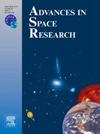Intensity of 27-day variations in solar emission and ionospheric electron content
IF 2.8
3区 地球科学
Q2 ASTRONOMY & ASTROPHYSICS
引用次数: 0
Abstract
The rotation of the Sun modulates solar emission with 27-day variations. Large-scale structures in the solar atmosphere, like sunspots and plages, rotate with the Sun and emit at extreme ultraviolet (EUV) and microwaves that produce the varying part of the emission. As EUV emission is the main driver of ionization in the Earth ionosphere, its variations are reflected in the electron content. In this paper, we analyze wide range of data from radio emission in 245–17000 MHz range and the entire EUV spectrum to total and global electron contents (TEC and GEC, respectively) in the ionosphere to find out where the 27-day variations are most prominent. We show that the relative contribution of 27-day variations to radio emission is maximal at 1000 MHz and decreases at 245 and 17000 MHz. The variations are pronounced throughout the EUV spectrum, their intensity vary at different spectral lines and, on average, is higher than in radio emission. The distribution of the variations in global ionospheric maps (GIM) shows an intensification of 27-day variations in TEC in the North America region, which can be related to the winter anomaly as it is also more significant in this region. Temporal variations of the 27-day component of emission are similar in shape for radio and EUV emission, as well as for GEC, and have a high correlation, up to 0.8. Cycle-averaged temporal variations imply that the 27-day component weakens significantly during solar minimum but can intensify during the remaining phases of the solar cycle. We also find that the flux at 1000 MHz, which originate from free-free emission in contrast to F10.7, can be used as a proxy index of solar activity because it has the highest intensity of 27-day variations and has been observed since 1956.
求助全文
约1分钟内获得全文
求助全文
来源期刊

Advances in Space Research
地学天文-地球科学综合
CiteScore
5.20
自引率
11.50%
发文量
800
审稿时长
5.8 months
期刊介绍:
The COSPAR publication Advances in Space Research (ASR) is an open journal covering all areas of space research including: space studies of the Earth''s surface, meteorology, climate, the Earth-Moon system, planets and small bodies of the solar system, upper atmospheres, ionospheres and magnetospheres of the Earth and planets including reference atmospheres, space plasmas in the solar system, astrophysics from space, materials sciences in space, fundamental physics in space, space debris, space weather, Earth observations of space phenomena, etc.
NB: Please note that manuscripts related to life sciences as related to space are no more accepted for submission to Advances in Space Research. Such manuscripts should now be submitted to the new COSPAR Journal Life Sciences in Space Research (LSSR).
All submissions are reviewed by two scientists in the field. COSPAR is an interdisciplinary scientific organization concerned with the progress of space research on an international scale. Operating under the rules of ICSU, COSPAR ignores political considerations and considers all questions solely from the scientific viewpoint.
 求助内容:
求助内容: 应助结果提醒方式:
应助结果提醒方式:


